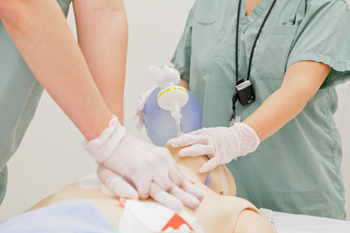Shifting how we think about simulation

By Emily Dawson

When the Allan Waters Family Simulation Centre at St. Michael’s Hospital opened its doors in 1996, it was just the second facility of its kind in Canada. Designed to provide training programs for University of Toronto medical students, it positioned St. Michael’s as a pioneer of integrating simulation into the medical curriculum.
Much like the centre itself, the role of simulation has evolved considerably since those early days.
“Our growth really started with the move from one room in the hospital to a state-of-the-art facility in the Li Ka Shing Knowledge Institute and the establishment of a new team of experts,” said Nazanin Khodadoust, director of Technology-Enabled Education.
“We achieved a significant milestone in 2015 with accreditation from the Royal College of Physicians and Surgeons of Canada, nationally recognizing the program for adopting the most rigorous standards of best practices in simulation.”
A central component of accreditation is the shift from single-profession to interprofessional simulations. Eight years ago, 90 per cent of simulations in the centre were designed for a single profession; today, 60 per cent are designed for interprofessional teams.
The importance of this change was brought to life a few year ago when members of the Cardiovascular team participated in an educational simulation that taught nurses, residents and physicians how to revive a non-responsive patient by opening the chest and massaging the heart.
Two weeks later, a nurse who participated in the simulation encountered this exact scenario. The team working that night initially resisted her recommendation to use the technique she had just learned. Applying the communication strategies they also taught in the simulation, she successfully flattened the hierarchy and persuaded the doctors. Together, they saved a life that night.
Despite the number of sim participants tripling in the last five years, there’s still a need to build awareness of the scope of opportunities for simulation.
“There’s a misconception that it’s only used for education. While that’s a big part of our mandate, there are many other roles for simulation,” said Christine Léger, a simulation educator in the centre.
“We use it for research, quality improvement and patient safety initiatives, and even for space and policy design. It’s no longer just a teaching tool, and every simulation is designed to positively impact patient care in some way.”
The sim team has built a strong and important partnership with the Quality department.
“We’re a leader in using simulation in the clinical environment, at the point-of-care, for quality improvement purposes. It’s also the best opportunity to measure the impact of simulation on practitioners, the environment, and ultimately on patient care,” said Khodadoust.
One such program, called First Five, aims to improve resuscitation outcomes in the time between calling a Code Blue and the code team’s arrival. It provides the opportunity for front-line staff to practice their emergency responsiveness with their own equipment, in their own space.
“We’ve implemented these sessions in most areas of the hospital now. It started with a simulation to understand the delayed response that sometimes occurs when Code Blue buttons are pressed. The debriefing with staff after the simulation uncovered latent safety threats and system issues that were causing the delays, which we were able to help solve,” said Léger.
Khodadoust points to the new Intensive Care Unit in the Peter Gilgan Patient Care Tower as an example of how simulation was used to design better patient spaces.
“This collaboration between the simulation, ICU, engineering, design, carpentry, information technology, and facilities teams was part of a research project about human factors that should be taken into consideration when designing an ICU room, and it led to the final design of this unit,” she said.
While St. Michael’s has the most mature sim program within Unity Health Toronto, there is active engagement with the teams at St. Joseph’s Health Centre and Providence Healthcare to continue building their capacity to design and deliver simulations best suited to their patient populations.
“We want to lift the organization by encouraging people to think broadly of how sim can be applied in their work, and we’re here to support these efforts,” said Léger.
About St. Michael’s Hospital
St. Michael’s Hospital provides compassionate care to all who enter its doors. The hospital also provides outstanding medical education to future health care professionals in more than 27 academic disciplines. Critical care and trauma, heart disease, neurosurgery, diabetes, cancer care, care of the homeless and global health are among the Hospital’s recognized areas of expertise. Through the Keenan Research Centre and the Li Ka Shing International Healthcare Education Centre, which make up the Li Ka Shing Knowledge Institute, research and education at St. Michael’s Hospital are recognized and make an impact around the world. Founded in 1892, the hospital is fully affiliated with the University of Toronto.
About Unity Health Toronto
Unity Health Toronto, comprised of Providence Healthcare, St. Joseph’s Health Centre and St. Michael’s Hospital, works to advance the health of everyone in our urban communities and beyond. Our health network serves patients, residents and clients across the full spectrum of care, spanning primary care, secondary community care, tertiary and quaternary care services to post-acute through rehabilitation, palliative care and long-term care, while investing in world-class research and education. For more information, visit www.unityhealth.to.
